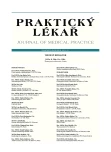Basics of social cognitive and affective neuroscience
XXII. Freud 2012
Authors:
F. Koukolík
Authors‘ workplace:
Primář: MUDr. František Koukolík, DrSc.
; Národní referenční laboratoř prionových chorob
; Thomayerova nemocnice, Praha
; Oddělení patologie a molekulární medicíny
Published in:
Prakt. Lék. 2012; 92(8): 431-436
Category:
Editorial
Overview
Some Freudian constructs may have neurobiological substrates. Freud’s descriptions of the primary and secondary processes, of the Id and Ego are in some degree consistent with the structure and function of the homeostatic/interoceptive, exteroceptive and default/implicite systems. All of consciousness may be dependent on evolution of affective experiences arising at upper brain stem level. Freud´s Id may be a conscious Id.
Key words:
Freud, Id, Ego, consciousness, homeostatic system, sensory cortical systems, default system
Sources
1. Adrie, D.R., Wong, A.T., Schacter, D.I.: Remembering the past and imagining the future: common and distinct neural substrates during event construction and elaboration. Neuropsychologia 2007; 45, p. 1363–1377.
2. Agrillo, Ch.: Near-death experience: out-of-body and out-of-brain. Rev Gen Psychol 2011;15, p. 1–10.
3. Bruyer, P., Kolilas, S.S., Mueri, R.M., et al.: Beyond remembering: phantom sensations of congenitally absent limbs. Proc. Natl. Acad Sci USA 2000; 97, p. 6167–6172.
4. Buckner, R.L., Andrews-Hanna, J.R., Schacter, D.L.: The brain’s default network. Anatomy, function and relevance to disease. Ann NY Acad Sci 2008; 1124, p. 1–38.
5. Carthart-Harris, R.L., Friston, K.J.: The default-mode, ego funtions and free energy: a neurobiological account of Freudian ideas. Brain 2010, 133, p. 1265–1283.
6. Clark,V.P., Keil, K., Maisog, J.M., et al.: Functional magnetic resonance imaging of human visual cortex during face matching: a comparison with positron emission tomography. Neuroimage 1996;4, p. 1–15.
7. Craig, A.D.: How do you feel? Interoception: the sense of the physiological condition of the body. Nat Rev Neurosci 2002; 3, p. 655–666.
8. Craig, A.D.: Interoception: the sense of physiological condition of the body. Curr Opin Neurobiol 2003; 13, p. 500–505.
9. Craig, A.D.: How do you feel-now? The anterior insula and human awareness. Nat Rev Neurosci 2009; 10, p. 59–70.
10. Critchley, H.: The human cortex responds to an interoceptive challenge. Proc Natl Acad Sci 2004; 101, p. 6333–6334.
11. Critchley, H.D., Siena, S., Rothestein, et al.: Neural systems supporting interoceptive awareness. Nat Neurosci 2004; 7, p. 189–195.
12. Ehrson, H.H., Rosen, B., Stockselius, A., et al.: Upper limb amputees can be induced to experience a rubber hand as their own. Brain 2008; 131, p. 3443–3452.
13. Freud, S.: Entwurf einer Psychologie [on-line]. Dostupné na www.lutecium.fr/Jacques_Lacan/ transcriptions/freud_esquisse_de.pdf.
14. Freud, S.: The Ego and the Id. In: Standard edition of the complete psychological works of Sigmund Freud. London UK: Hoggarth, 1938, vol. 19, p. 12–59.
15. Freud, S.: An outline of psychoanalysis. In: Standard edition of the complete psychological works of Sigmund Freud. London UK: Hoggarth, 1938, vol. 23, p. 198.
16. Greene, J.D., Sommerville, R.B., Bystrém, L.E., et al.: An fMRI investigation of emotional engagement in moral judgement. Science 2001; 293, p. 2105–2108.
17. Hahn, B., Ross, TJ., Stein, E.A.: Cingulate activation increases dynamically with response speed under stimulus unpredictability. Cereb Cortex 2007; 17, p. 1664–1671.
18. Koukolík, F.: Lidský mozek. Funkční systémy. Norma a poruchy. Třetí, přepracované a doplněné vydání. Praha: Galén, 2012.
19. Koukolík, F.: Evoluce a evoluční teorie pro lékaře X. Sebeuvědomování. Prakt. Lék. 2010, 90(10), s. 571–576.
20. Koukolík, F.: Základy kognitivní, afektivní a sociální neurovědy: XVIII. Interocepce a emoční pozadí. Prakt. Lék. 2012, 92(5), s. 251–256.
21. Koukolík, F.: Já. O mozku, vědomí a sebeuvědomování. Praha: Karolinum, 2013. V tisku.
22. Li,C.S.R., Yan, P., Berquist, K.L., et al.: Greater activation of the „default“ brain regions precede stop signal errors. NeuroImage 2007; 38, p. 640–648.
23. Mason, M.F., Bortin, M.I., Van Horn, J.D. et al.: Wandering minds: the default network and stimulus-independent thought. Science 2007; 315. p. 393–395.
24. McGonigle, D.J., Hänninen, R., Salenius, S., et al.: Whose arm it is anyway? An fMRI case study of supernumerary phantom limb. Brain 2002; 125, p. 1265–1274.
25. Merker, B.: Consciousness without a cerebral cortex: a challenges for neuroscience and medicine. Behavioral Brain Sciences 2007, 30, p. 63–134.
26. Moruzzi, G., Bagoun, H.: Brain stem reticular formation and activation of the EEG. Electroencephalog Clin Neurol 1949, 1, p. 455–473.
27. Petkova, V.I., Ehrsson, H.H.: If I were you: perceptual illusion of body swapping. PLoS ONE 2008. Doi:10.1371/Journal.pone0003832.
28. Reichle, M.E., McLeodm M., Snyder, A., et al.: A default state of brain function. Proc Natl Acad Sci USA 2001; 98, p. 676–682.
29. Ramachandran, V.S., Rogers-Ramachandran. D.: Phantom limbs and neural plasticity. Arch. Neurol. 2000; 57, p. 317–320.
30. Shimada, S., Fukuda, K., Hiraki, K.: Rubber hand illusion under delayed visual feedback. PLoS ONE 2009; 4(7): e6185. doi:10.1371/journal. pone.0006185.
31. Solms, M., Panksepp, J.: The „id“ knows more than the „ego“ admits: neuropsychoanalytic and primal conscious perspectives on the interface between affective and cognitive neuroscience. Brain Sci 2012, 2, p. 147–175.
32. Tulving, E.: Episodic memory: from mind to brain. Annu Rev Psychol 2002; 53, p. 1–25.
Labels
General practitioner for children and adolescents General practitioner for adultsArticle was published in
General Practitioner

2012 Issue 8
Most read in this issue
- Marijuana: risks and short intervention
- Interstitial lung diseases and bronchiolar involvement
- A review of guidelines for implementation of physical activity in the primary prevention of diseases
- Sarcosine in urine of patients with prostate carcinoma
